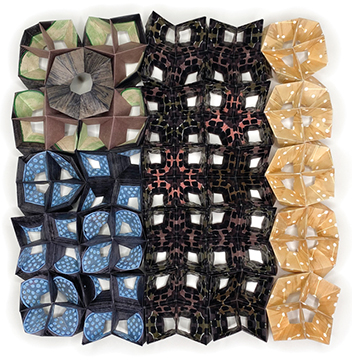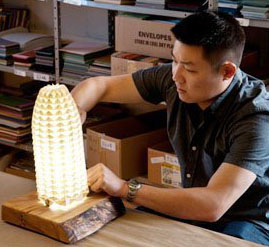
10 Flint Avenue, P.O. Box 398, Bancroft, Ontario K0L 1C0 Phone 613-332-1542 email: artgalleryofbancroft@gmail.ca
Proudly supported by:

Opening reception:
Thursday, Month 3 | 7:30 pm
![]()

Artworks for the exhibit are made using Ooi’s stage-based technique. He cuts, creases, paints, folds and assembles hundreds to thousands of sheets individually by hand to shape his reliefs and sculptures. However, in keeping with the exhibition theme, Ooi incorporated a subtle change, or difference, an “interruption” disguised and constructed by his usual method. In every work the device is different – an adjustment in scale, size, symmetry, pattern or colour – encouraging the viewer to take a closer look of the sophistry that can exist in illusion and transformation.

Andrew Ooi (pronounced oo-ee, like “gooey”) is a Canadian visual artist. He creates multi-planar sculptures and reliefs, “carving” each shape, line, and shade entirely out of paper, realizing a sculptural quality out of what is otherwise considered flat. Through his stage-based process he cuts, creases, paints, folds, and assembles hundreds to thousands of sheets. Each artwork can take anywhere from weeks to months to complete as he meditates on a subject of interest, like anthropology, history, identity, resilience, and—for the exhibit, Without Interrupting the System—transformation. His works have been published by Bloomsbury, Rockport, Uppercase and more; awarded multiple grants, and exhibited in various galleries and fairs in Canada and across the US, including Pittsburgh, Los Angeles, Washington and New York. He currently lives in Toronto, Canada.
Without Interrupting the System, by Andrew Ooi, is a collection of paper artworks considering ideas about transformation, perception and illusion occurring in media and society today.
Leading to the 2016 US election, Ooi noticed an interesting phenomenon overtaking news journalism. Print and network media were incorporating opinions and assumptions into their daily broadcast, and usually, simultaneously. These outlets did so by employing traditional journalistic devices, like imagery, language, editing and repetition, similarly but to different effect. The result was news that was increasingly imperceptible, requiring it to be “explained” to the reader or viewer. For Ooi, the explanation signalled a dramatic transformation about news reporting: that it now included an element of illusion, “without interrupting the system,” which if not careful to recognize, could influence public belief, thought and perception.
To situate the phenomenon in art history, Ooi revisited the works of artists M.C. Escher (1898–1972) and Victor Vasarely (1906–1997). Masters of illusion, their use of symmetry, gradation, contrast, geometry, space and exchange of picture-planes provided the necessary insight in conceiving the exhibition. Additionally, in studying their approach of design and perspective, Ooi too underwent his own personal transformation: of understanding the nuances of his own process and the very moment his works changeover from painting to sculpture, and back again, blurring the distinction between the two.
Of special note, the paper used for the artworks in Without Interrupting the System is traditionally-handmade, washi Japanese gampi. Gampi is a rare type of shrub, wild and difficult to cultivate, indigenous to Japan. Its root is used as the pulp to make this extremely prized and durable paper, usually reserved for important documents, formal ledgers or marriage certificates; prints during the Edo Period (1603-1868) and of artists Rembrandt, Pablo Picasso and Marc Chagall, to name a few. Unfortunately, due to a number of contributing factors including cultivation, the passing on of traditions, expense and demand, gampi washi has ceased to be in production. In 2014, the United Nations Educational, Scientific and Cultural Organization (UNESCO) landed “Washi, craftsmanship of traditional Japanese handmade paper,” on its Intangible Cultural Heritage list.
Ooi purposely used gampi washi for the exhibition as it is a physical embodiment of the theme and all the qualities he admires of the material and his fondness for working with it, and paper, in general: utility, durability, care and craft. For assistance in acquiring the last of these papers, and presentation of this exhibit, Ooi was awarded two Ontario Arts Council (OAC) grants. And so it is with great esteem that Andrew Ooi would like to acknowledge the Ontario Arts Council for supporting the creation of this work and the heritage and craft that has made it possible.

10 Flint Avenue, P.O. Box 398, Bancroft, Ontario K0L 1C0 Phone 613-332-1542 email: artgalleryofbancroft@gmail.ca
Proudly supported by:

Charitable Registration #: 81973 7750 RR0001
How to Pay
Etransfer to artonflint@gmail.com
(Don’t forget to include your email address in the etransfer for your tax receipt!)
Drop in at the Gallery or mail us a cheque:
AGB, 10 Flint Avenue, P.O. Box 398, Bancroft, ON K0L 1C0
The Art Gallery of Bancroft is situated on the traditional territory of the Anishinaabeg Algonquins, which is known to be unceded. Indigenous people have been stewards of this land since time immemorial; as such we honour and respect their connection to the land, its plants, animals and stories. Our recognition of the contributions and historic importance of Indigenous peoples is sincerely aligned to our collective commitment to make the promise and the challenge of truth and reconciliation real in our community.